Strategic Planning is a crucial step in achieving business success.
But did you know that 48% of organizations fail to meet their strategic goals?
This is why strategic planning is a vital process for organizations looking to stay ahead of the competition. It involves assessing an organization’s current position and creating a roadmap to reach its desired future state.
Strategic planning software help you navigate the challenges that come with growth and expansion. These softwares serve various purposes, like data analysis, creating visual representations of strategy, collaborating with team members, tracking progress and so much more.
In this blog, we will be discussing the top 15 strategic planning softwares in 2025 that can help organizations streamline their planning processes and achieve objectives. From established software solutions to emerging tools, we will explore the features and benefits of each tool, making it easier for organizations to choose the best fit for their unique needs.
Top 15 Software for Strategic Planning
1. Peoplebox
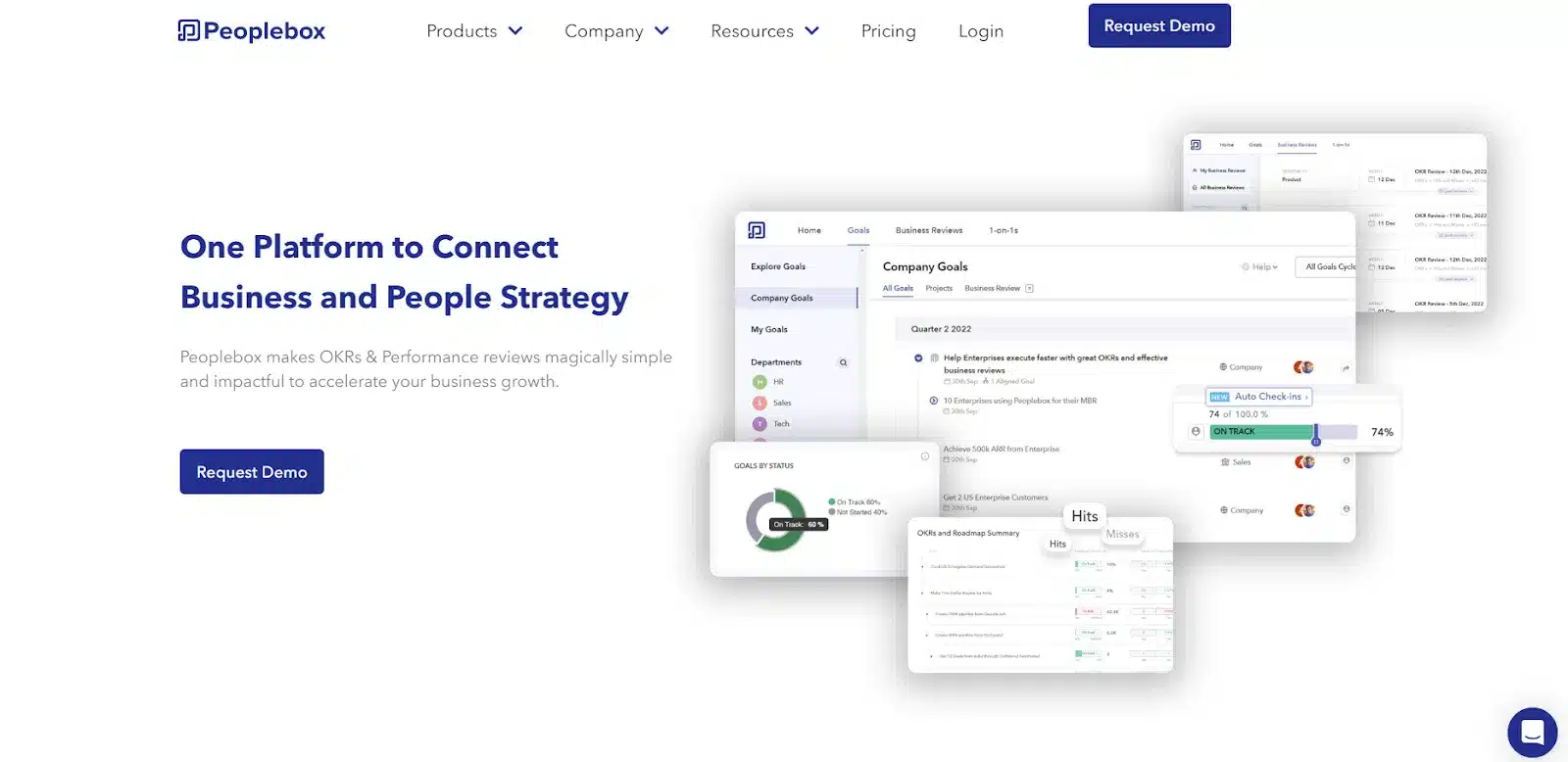
Peoplebox is a popular tool for strategic planning and execution that transforms strategies into tangible results. It has gained popularity among enterprises due to its ability to foster an outcome-driven culture through its robust OKR and performance management solutions.
It seamlessly integrates with all major work tools, including SQL, Jira, Hubspot, MS Teams, and Asana, Slack, Trello and more. This makes it easy for companies to align and track their strategic priorities. With Peoplebox, tracking cross-functional goals becomes a breeze, without the need for additional software solutions.
As a Y Combinator-backed company, Peoplebox has helped over 500 leading companies achieve faster results by providing excellent goal-setting assistance and progress-monitoring capabilities. Some of the companies using Peoplebox are Razorpay, Veriff, Disney, Postman, Khatabook, and Exotel.
Notable Features
1. Comprehensive tool
Peoplebox is an all-in-one platform that offers a comprehensive solution for managing various aspects of business, including strategic planning, setting goals and tracking OKRs, conducting effective business review meetings, monitoring KPIs, managing employee performance, and driving engagement among employees.
2. Integration with 100+ native tools
Peoplebox allows integration with 100+ native tools, like Slack, Jira, Asana, MySQL, Google Sheets, Trello, Salesforce and many others. It auto-updates your goals in real time with these integrated tools, creating auto-populated dashboards for your business reviews and weekly check-ins. This helps you stay abreast with the latest insights and enables you to make informed decisions if and when required.
3. Customizable dashboards for effective business reviews
Peoplebox also offers customizable dashboards, letting you add KPIs, narrations, charts, action items, and more to auto-populate OKR progress. This helps you conduct effective weekly and monthly business review meetings by identifying roadblocks ahead of time, so teams can focus on solving them.
4. Deep Slack/ MS Teams Integration
With Peoplebox, you can drive the entire interface using Slack/ MS Teams. The 360-degree review allows you to manage everything, auto-updating OKRs and KPIs in real-time, auto-scheduling 1:1s for data reviews, and allowing you to customize the review process as per your needs. It manages every little thing from nudges, reminders, and self-reviews to goal check-ins, tracking the performance review process entirely from Slack or MS Teams.
5. Real-time tracking
Peoplebox provides real-time tracking of goals, with a unified view of strategic priorities, and progress on OKRs, projects, initiatives and KPIs.
6. Single-page view for ease of use
One of the key features of Peoplebox is its single-page software, offering a complete view of all company goals, team tasks, individual performances, progress reports, charts, and more. This makes it easy to use and navigate, easing the process of goal setting and monitoring with its simple yet effective UI.
2. Jira
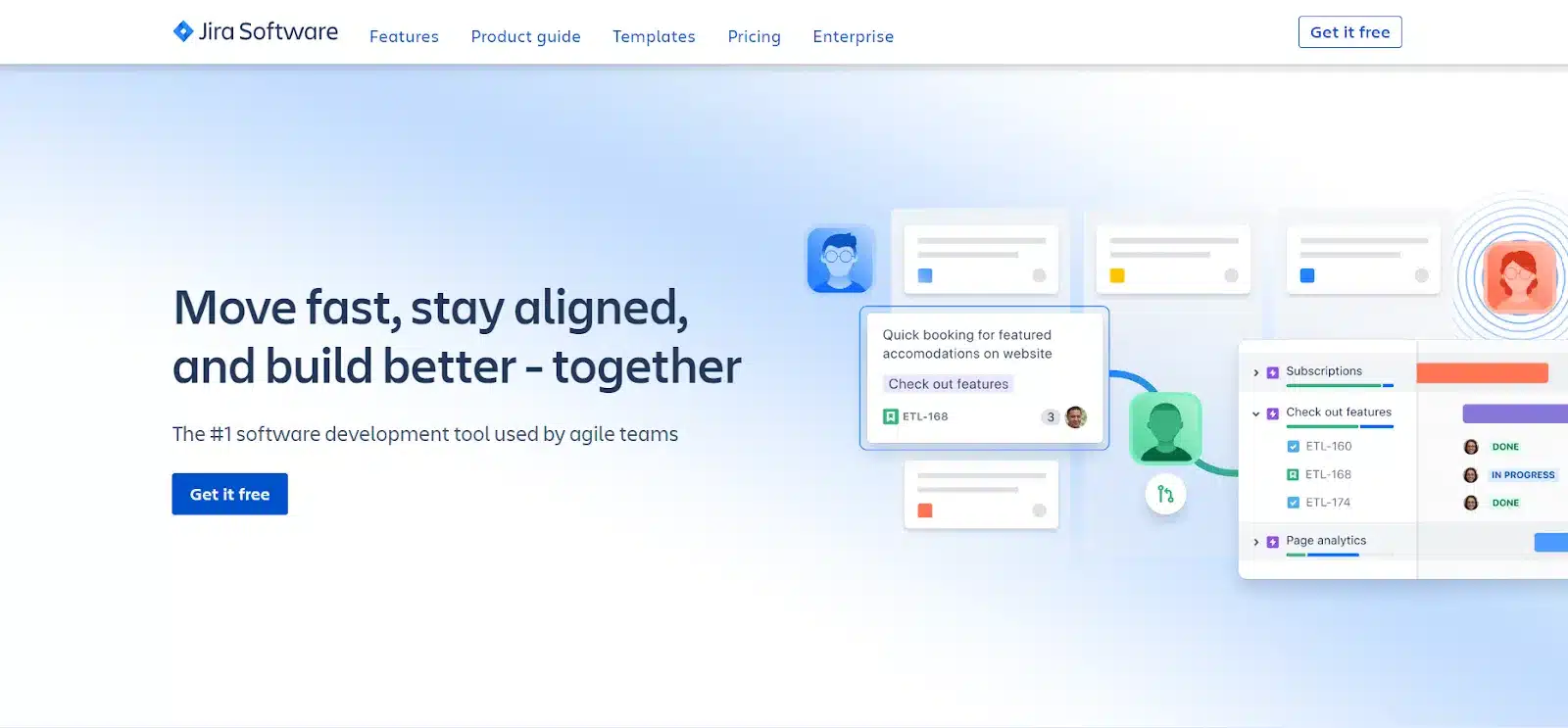
Jira is a project management tool developed by Atlassian that is used by teams to track and manage their work. It provides a range of features and functionalities designed to help teams plan, track, and release their software projects.
One of the key features of Jira is its customizable workflows, which allow teams to create workflows that align with their specific needs and requirements.
Notable Features
1. Reporting capabilities
Jira provides pre-built reports and dashboards that offer valuable insights to keep teams informed and on track. This feature helps teams stay up-to-date with their progress, analyze workload using Sprint reporting, and identify areas of overcommitment or excessive scope creep. These insights can help teams make data-driven decisions to improve their efficiency and productivity.
2. Agile Boards
Jira offers agile boards, including Scrum and Kanban boards, that allow teams to divide complex projects into smaller, more manageable tasks, ultimately leading to faster delivery times. These boards provide the flexibility to visualize workflows and limit work-in-progress, which maximizes efficiency as a team. Whether teams prefer Scrum, Kanban, or a combination of both, Jira is a customizable tool that can be adapted to suit different working styles.
3. Roadmaps
Jira’s roadmap feature is designed to help teams manage projects effectively. It ensures that teams and organizations are aligned, enabling quick decision-making while staying focused on achieving the bigger picture. Roadmaps provide a way to plan and track progress on an overall project for a single team, keeping everyone informed and on track.
Pros of Jira
- Jira offers real-time dashboards and reports that can be customized to provide insights into project status, team performance, and progress towards goals.
- Jira offers a robust integration with other tools commonly used by development teams, such as GitHub, Bitbucket, and Confluence. This integration allows teams to streamline their workflow, track code changes, and collaborate on documentation in real-time.
- Jira provides a comprehensive issue tracking system that allows teams to manage tasks, bugs, and other issues with ease.
Cons of Jira
- Jira can be complex and overwhelming for new users due to its many features and customizable options. This can result in a steep learning curve, which may require additional training or resources to overcome.
- Jira can be relatively expensive compared to other project management software on the market. The cost may be prohibitive for smaller teams or organizations with limited budgets.
- Collaborating on cross-functional projects can be challenging sometimes. For instance, in the case of involvement of three different teams, with changes occasionally restricted to a specific group and at times open to all. Changes are reflected in all the teams despite the restriction.
3. Asana
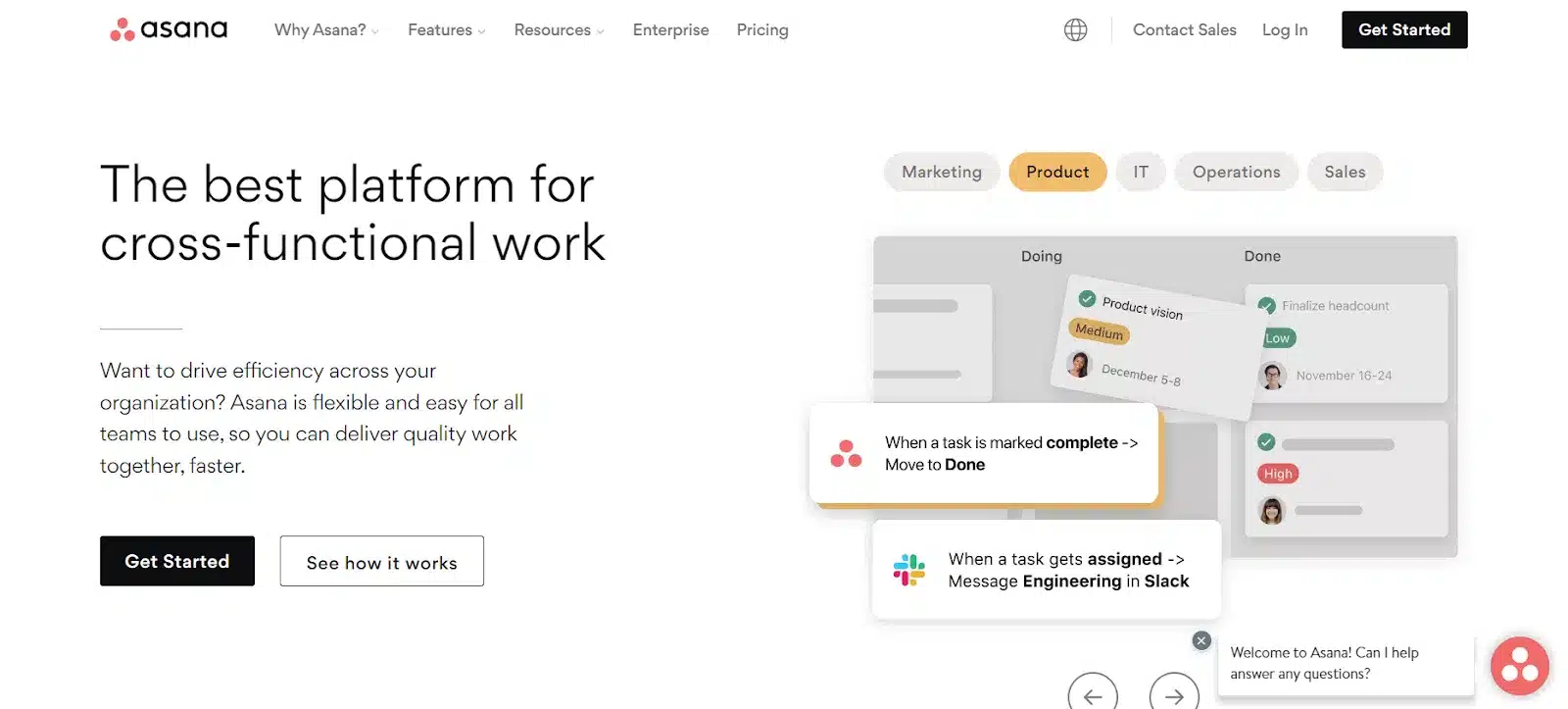
Asana is a project management tool that helps teams manage their tasks and workflows efficiently. It is designed to help teams plan, track and manage their work, from daily tasks to large-scale projects, with ease.
Asana offers you the ability to visualize and organize workflows, allowing teams to manage and track their tasks in a collaborative and transparent way. It offers a variety of tools to help plan, view projects, including lists, boards, and timelines, making it easy for teams to choose the view that suits their needs.
Notable Features
1. Goal setting
Asana allows you to set and achieve strategic goals by connecting company goals and the work to support them in one place. This helps teams stay on track and work more efficiently. It helps keep them on top of mind, allowing teams to align their efforts and move in one direction. This alignment helps reduce conflicts within the organization.
2. Reporting
Asana offers universal reporting to help businesses get a bird’s-eye view of the status of their objectives in real time. This helps organizations identify roadblocks and course-correct to keep their teams on track, ultimately driving business outcomes.
3. Workflow Builder
Asana’s Workflow Builder helps teams to create and connect processes from start to finish. It serves as a single source of truth that facilitates coordination and alignment towards goals, making it easy to organize work across teams. The Workflow Builder enhances clarity by enabling more team members to set up processes, report on progress, and share the information with other teams.
Pros of Asana
- Asana is a flexible project management solution that can be used for projects of any scale, from small to large.
- Asana’s interface is user-friendly, making it easy for non-technical users to navigate and utilize the platform’s basic features.
- It offers a range of customization options that allow users to adapt the tool to their unique requirements.
Cons of Asana
- Asana does allow you to assign tasks to more than one person for collaborative projects.
- New users may find it overwhelming and challenging to navigate and use the tool efficiently because of the extensive features on Asana
- Asana is more expensive than other software in the market.
4. Cascade
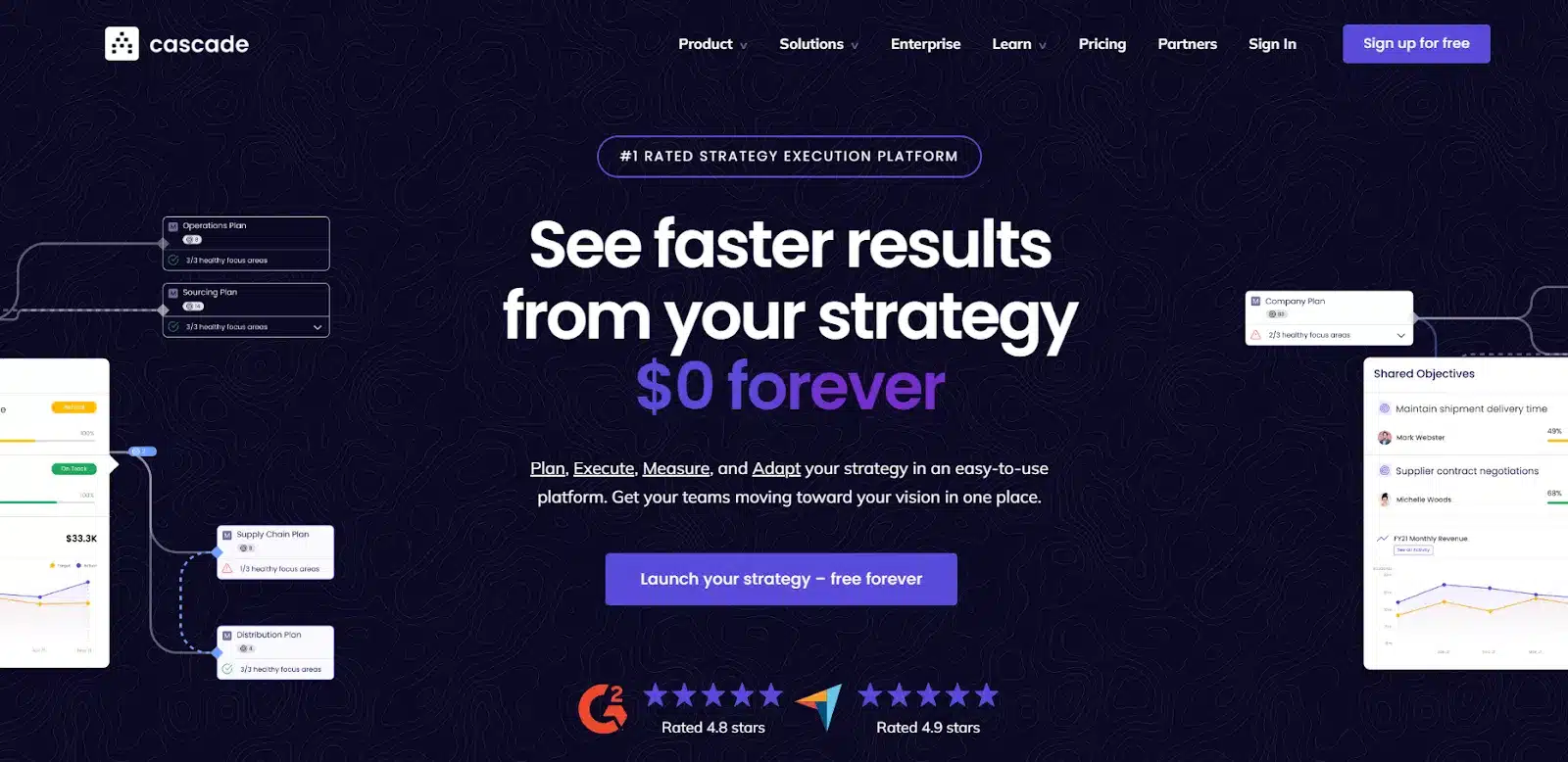
Cascade is a strategic planning and execution platform that helps businesses manage their strategy, goals, and performance. It offers a comprehensive suite of features to help organizations streamline their planning processes, including strategy development, goal-setting, project management, and performance tracking. Cascade aims to bring together every aspect of strategic planning and execution in one centralized platform.
Notable Features
1. Strategic planning
Cascade enables businesses to easily develop a strategic plan by defining their vision, mission, values, and strategic priorities. The tool offers a range of pre-built templates to help businesses get started quickly. It allows teams to collaborate and share ideas, ensuring that everyone is on the same page and working towards the same goals.
2. Performance tracking
Cascade offers a range of metrics and visualizations to help businesses monitor their progress towards their goals, identify areas for improvement, and adjust their strategy accordingly. It provides real-time data and insights, allowing businesses to make data-driven decisions and stay ahead of the competition.
3. Birds Eye view
Cascade gives you a comprehensive overview of your data within seconds. By integrating with your preferred tools and consolidating all information in one location, Cascade allows you to easily monitor everything from one place. With its robust analytics capabilities, it helps you make informed decisions with confidence.
Pros of Cascade
- Cascade provides a centralized view of all ongoing projects and tasks, allowing teams to stay on top of their work and ensure that everything is progressing as planned.
- Cascade has an exceptional team for Customer Success which goes above and beyond to ensure the platform is customized to meet our specific requirements.
Cons of Cascade
- Onboarding can take a considerable amount of time in a large organization.
- Users might encounter minor challenges when trying to drag and drop goals to reorder them.
- The app requires a refresh in order to update. Small modifications are sometimes not reflected in the app even after being made.
- Snapshot Reports and Dashboards might have some delay in loading.
5. Hirebook
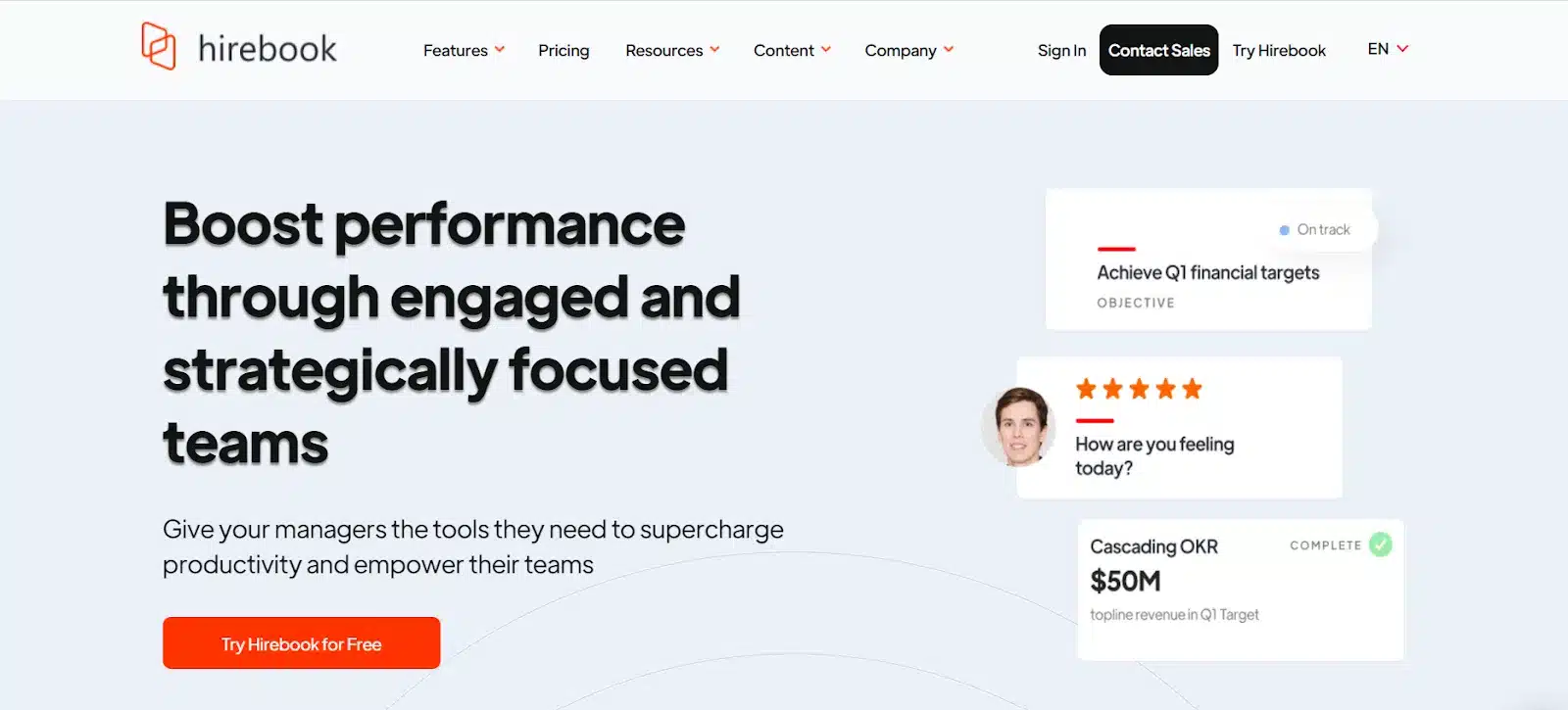
Hirebook is an HR management tool designed to streamline various HR processes and increase productivity. It offers a comprehensive suite of features that enable companies to manage employee performance, provide real-time feedback, set goals and objectives, track progress, and foster a culture of continuous improvement.
Hirebook’s goal-setting feature enables managers to set goals for their team members and track progress towards those goals in real-time. With this feature, managers can easily create SMART goals that are aligned with the company’s overall objectives.
Notable Features
1. Performance Management
Hirebook provides a comprehensive performance management system that enables managers to set goals, provide feedback, conduct regular check-ins, and track progress. With this feature, managers can align their team’s objectives with the company’s overall strategy, identify areas for improvement, and foster a culture of continuous learning and development.
2. Organizational Chart
This feature gives you full visibility of your organization’s performance. By utilizing your existing reporting structure, it allows you to effectively manage your team’s OKRs and execute your strategy flawlessly. This feature allows you to easily identify who belongs to each team and department, while also providing the ability to measure employee sentiment through regular check-ins.
3. Task Management
Hirebook’s Task Management feature helps in efficiently managing your day-to-day work. It turns conversations into actionable tasks, assigns due dates to the tasks and helps in effectively managing the daily work.
Pros of Hirebook
- Hirebook has an intuitive interface which makes it easy to set up and manage goals, assign them to specific team members, and track progress.
- Hirebook’s goal-setting feature allows for continuous feedback and collaboration between managers and their team members.
- It offers excellent customer service
Cons of Hirebook
- The tool has some minor bugs, such as issues with syncing certain meetings with Google Calendar.
- Users have experiences some extended page loading times and authentication issues during the signup process
6. Rhythm
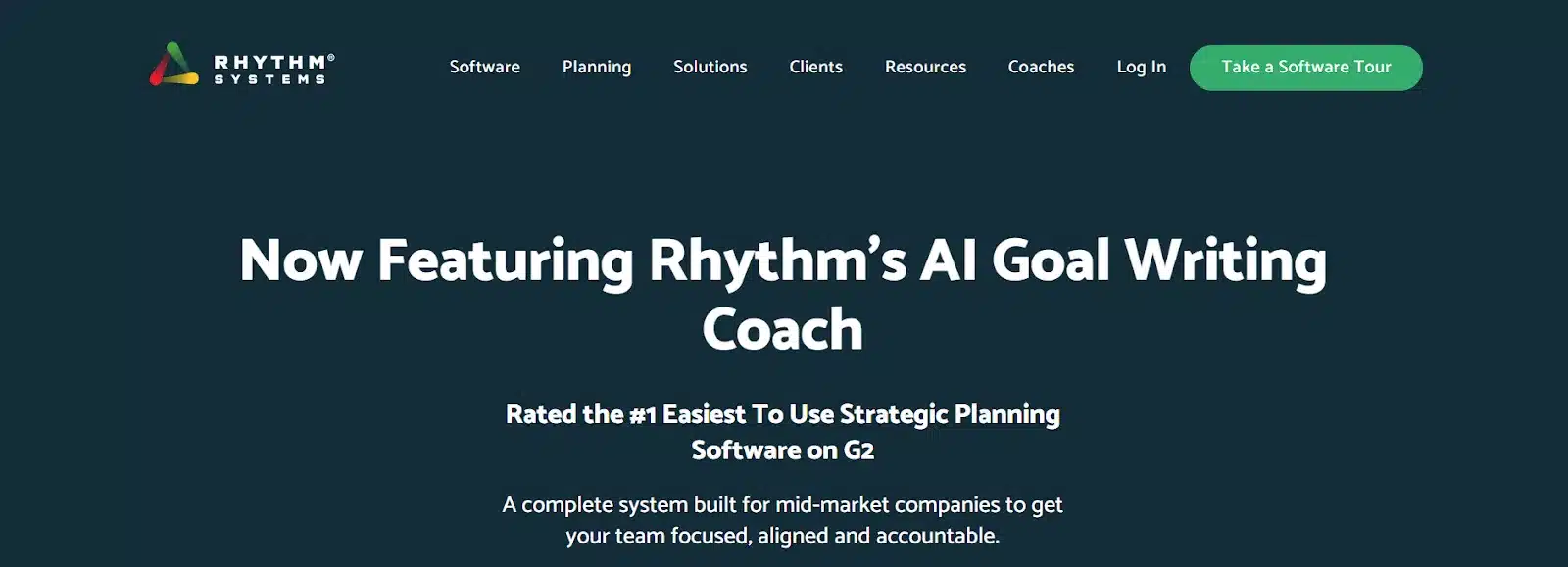
Rhythm is a comprehensive solution designed to help businesses effectively plan, execute, and measure their strategic goals. It provides a structured approach to strategic planning that aligns all stakeholders towards common objectives and promotes a culture of accountability.
The tool offers a variety of features to help businesses streamline their strategic planning process. These include goal-setting, SWOT analysis, strategy mapping, and cascading goals, etc.
Notable features
1. Strategic planning
Rhythm offers robust features to support strategic planning. It helps you generate growth plans that keep your team focused and accountable and helps you achieve revenue-boosting results. It has features that help you create custom agendas, idea ranking, etc. It breaks down the extensive plan into actionable tasks with the right KPIs to keep organizational alignment intact.
2. Alignment and Accountability
Rhythm ensures flawless execution of your strategic plan by setting accountability and getting your teams aligned. It helps you establish internal accountability, enabling everyone to focus on the same goals. By putting your strategy into a system, you can execute your plans predictably and with ease.
3. High performance culture
Rhythm’s High Performance Culture feature helps organizations foster a culture of excellence and achieve peak performance. This feature enables leaders to align their teams with the company’s goals, values, and vision, and drive performance improvements across the organization.
Pros of Rhythm
- Rhythm provides real-time visibility into progress towards goals and enables team members to track their own progress as well as that of their colleagues and upper management.
- Rhythm enables teams to align their goals with the organization’s overall strategy, creating a clear sense of purpose and direction.
- Rhythm enables easy tracking of own tasks and receiving tasks from team members regardless of physical location.
Cons of Rhythm
- Rhythm comes with a learning curve due to the abundance of features and capabilities.
- Although Rhythm is a good tool, its applicability may not extend seamlessly to other sectors such as education or nonprofit.
7. Perdoo
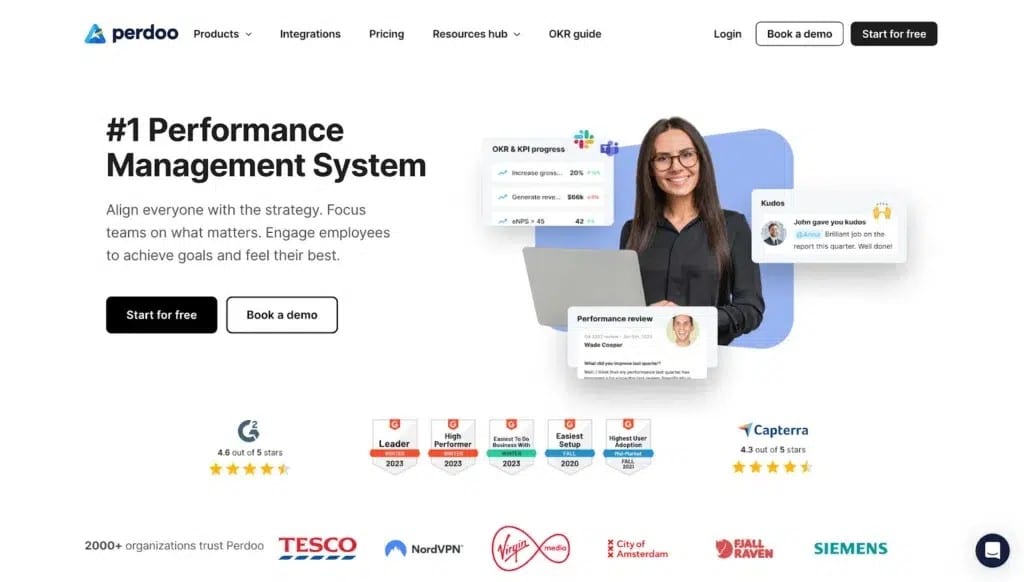
Perdoo is a strategic planning tool that facilitates organizations to set, track, and achieve their goals and key results (OKRs). This tool puts emphasis on employee engagement and alignment, helping businesses to remain focused on their objectives. Perdoo offers a user-friendly interface that enables teams to collaborate effectively and stay engaged.
Notable Features
1. KPI Board
Perdoo supports the alignment of KPIs and OKRs to ensure that both are fully integrated into your strategy through the KPI board. It provides a way to create meaningful connections and a deeper understanding of progress towards objectives. You can even set OKRs to improve KPIs and work towards achieving both simultaneously.
2. Real-time insights
Perdoo offers insights on real-time data, enabling you to quickly adapt and make important decisions. It also stores these learnings for future reference. By building customized reports and dashboards, Perdoo allows you to identify issues and adjust your course as needed.
3. Centralized platform
With Perdoo, you get everything in a centralized location – from strategy to goals and people. This makes tasks such as check-ins, 1:1s, and performance reviews more efficient and impactful than any other product in the market.
Pros of Perdoo
- Perdoo helps you gain a comprehensive view of your strategy and goals, from a high-level view to detailed level-by-level objectives, all within the same application.
- Perdoo facilitates a collaborative approach to the OKR method, enabling all team members to contribute, enhancing visibility and accountability.
- Perdoo’s user-friendly interface makes it easy for even non-tech users to navigate and use the application.
Cons of Perdoo
- Takes time to set up initially, specially for those new to OKRs. Despite the assistance and support, there’s a learning curve to the tool.
- Perdoo has its unique OKR model, which may differ from other familiar methods. Also, there are no shortcuts or pre-existing templates available. It can be overwhelming for those unfamiliar with the concept to start on a blank slate.
8. Microsoft Viva Goals
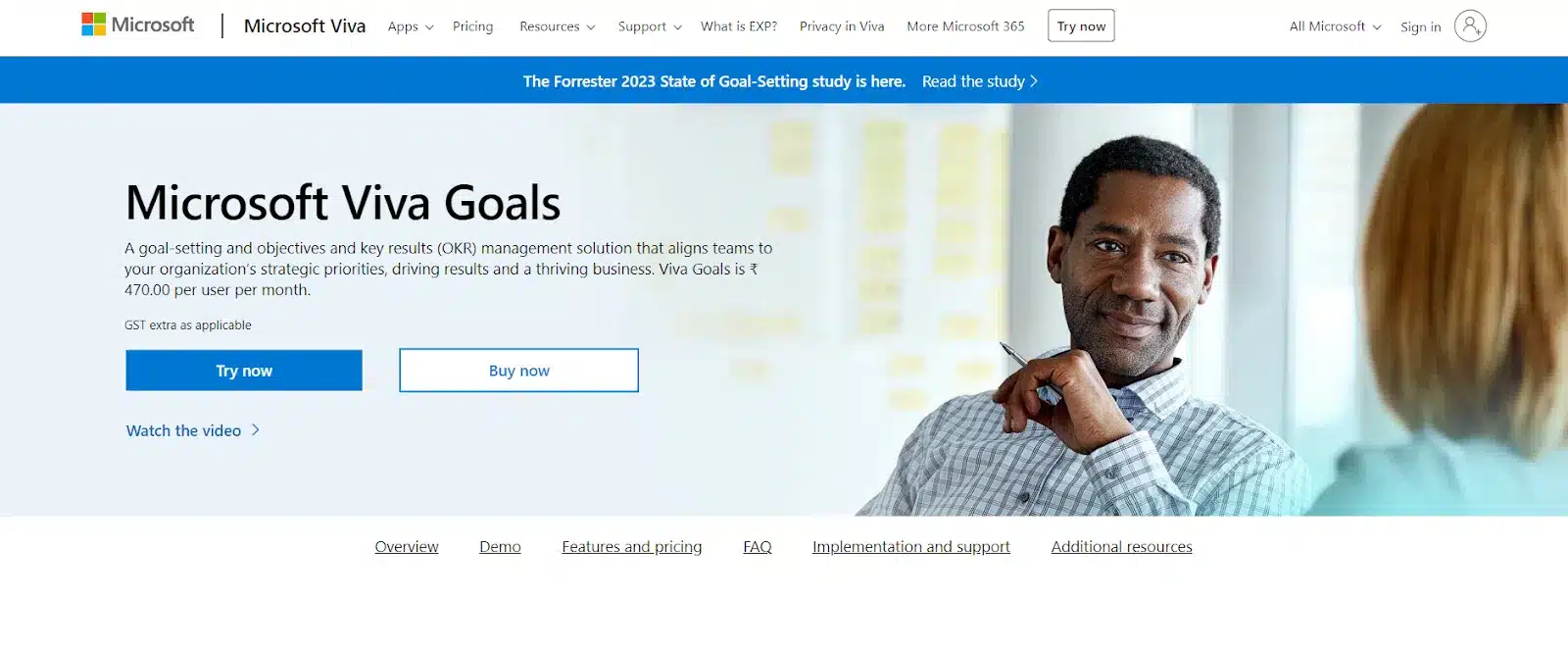
Microsoft Viva Goals, formerly known as Ally.io, is a software that facilitates the setting, tracking, and achievement of goals. It provides a centralized platform for goal management and execution, along with a host of features to assist users in managing their objectives effectively.
The software offers a comprehensive suite of capabilities, including OKR management, progress monitoring, real-time updates, collaboration tools, and reporting and analytics.
Notable Features
1. Engagement
To foster employee engagement, Microsoft Viva Goals provides several tools. These allow users to follow or pin people, teams, and reports within the platform, facilitating progress tracking. Users can express support by liking and commenting on others’ activities.
2. Review Dashboard
The Microsoft Viva Goals offers a Review Dashboard feature that enables users to organize and present data visually for different types of communication across various organizational levels. This includes all meetings, quarterly business reviews, as well as stand-ups and bi-weekly progress updates.
3. Collaboration
Microsoft Viva Goals offers seamless collaboration features for OKR planning with colleagues. It provides multiple visual displays to facilitate alignment, enabling users to collaborate and align their objectives with team and organizational goals.
Pros of Microsoft Viva Goals
- The app interface is user friendly and prioritizes creating OKRs management.
- The Review Dashboard feature enables teams to collaborate effectively, review data, identify potential risks, and stay focused on achieving company objectives.
Cons of Microsoft Viva Goals
- Creating personalized reports on the platform is difficult because of the restricted options for filtering data.
- It is challenging for users to utilize all of its functions and capabilities.
9. Quantive
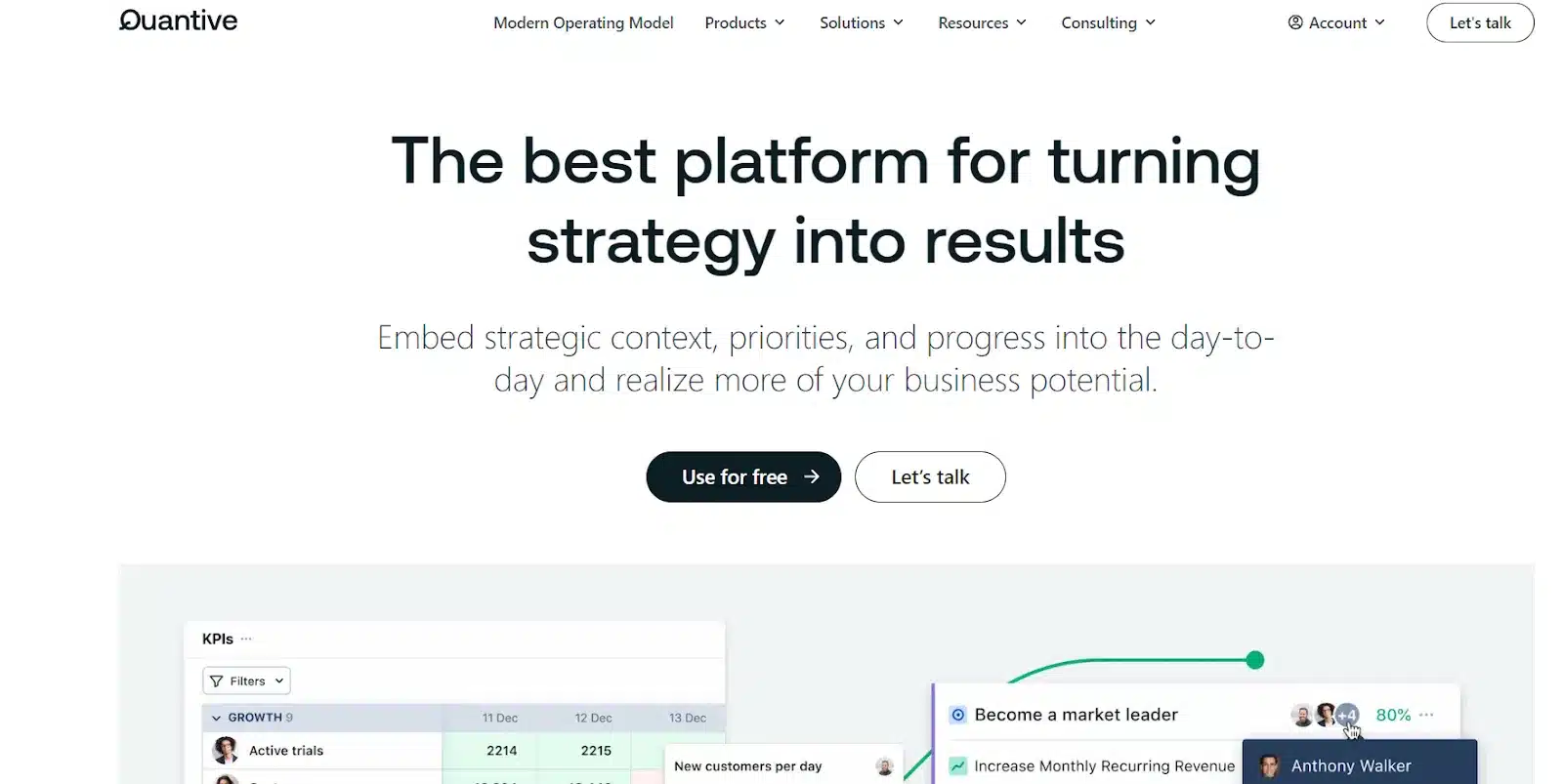
Quantive is a strategy planning and execution platform designed for contemporary businesses. It offers a range of tools that equip organizations with elements required to achieve success. By promoting alignment, visibility, and accountability across the entire organization, the platform provides a solid foundation for achieving business goals.
Notable Features
1. Quantive Signals
Quantive offers a functionality called Quantive Signals that helps gather, detect, scrutinize, and implement necessary actions when problems arise. It equips businesses with better observability and enables proactive measures to prevent potential issues.
2. Execution of Strategy
This software streamlines the process of planning, aligning, executing, assessing, and adapting strategies for teams. It lays the groundwork for enterprise success by facilitating agility and responsiveness to changing market conditions.
3. Reporting and Analysis
Quantive simplifies planning the next steps of a company’s strategy by providing valuable insights from past initiatives. This eliminates guesswork and aids in prioritizing tasks more effectively. It also streamlines the reporting process for making better decisions.
Pros of Quantive
- The tool is an excellent and easy solution for recording, tracking, updating, and managing OKRs.
- Users can start using it quickly and easily with minimal time and effort.
Cons of Quantive
- Customizing the Insight Boards in Quantive can be challenging and may require technical assistance.
- The tool has some bugs which causes it to run sluggish at times.
10. Profit.co
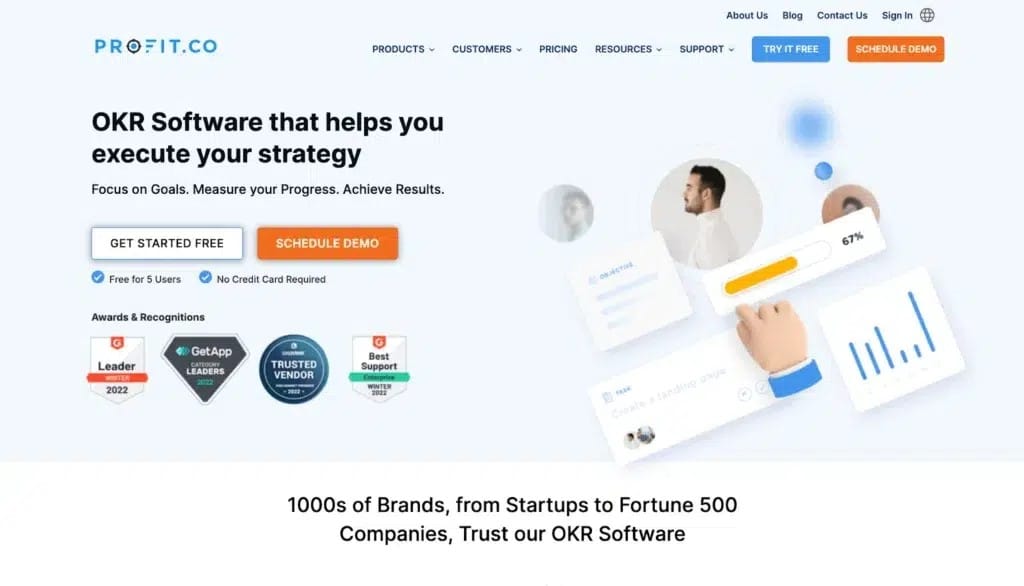
Profit.co is a strategy execution and OKR management platform that helps organizations to align, track, and manage their objectives and key results. The tool enables businesses to achieve success by providing a framework for planning, executing, and measuring their strategic goals.
Profit.co offers a variety of features to help users manage their OKRs and track their progress, including the ability to create, assign, and track goals across teams and departments.
Notable Features
1. OKR Management
With Profit.co, users can create and track multiple OKRs, align objectives with team and organizational objectives, assign and track progress on tasks and key results, and communicate and collaborate with team members in real time. It also provides advanced reporting and analytics features, allowing users to generate customized reports and gain insights into organizational performance.
2. Customizable KPIs
Profit.co offers over 400 customizable KPIs that are built-in to help users begin their OKR journey. It also provides various metrics to measure key results in cases where KRs are not easily measurable.
3. Goal Alignment
Profit.co streamlines the goal alignment process through a dashboard that provides visibility for all team members to comprehend company objectives and their individual contributions towards achieving them.
Pros of Profit.co
- The OKR dashboard provides a clear, real-time view of organizational progress towards key objectives, allowing for easy identification of areas that require attention.
- The automated check-ins help facilitate regular communication and accountability among team members
- It offers a variety of tools to foster collaboration such as the ability to add comments and feedback, share resources, and assign tasks.
Cons of Profit.co
- New users may find the tool overwhelming because of its extensive range of features, which can make it complex and difficult to navigate.
- The OKR management may appear difficult for new users, with limitations on alignment, mapping objectives to KRs, and selecting KPIs.
11. Aha!
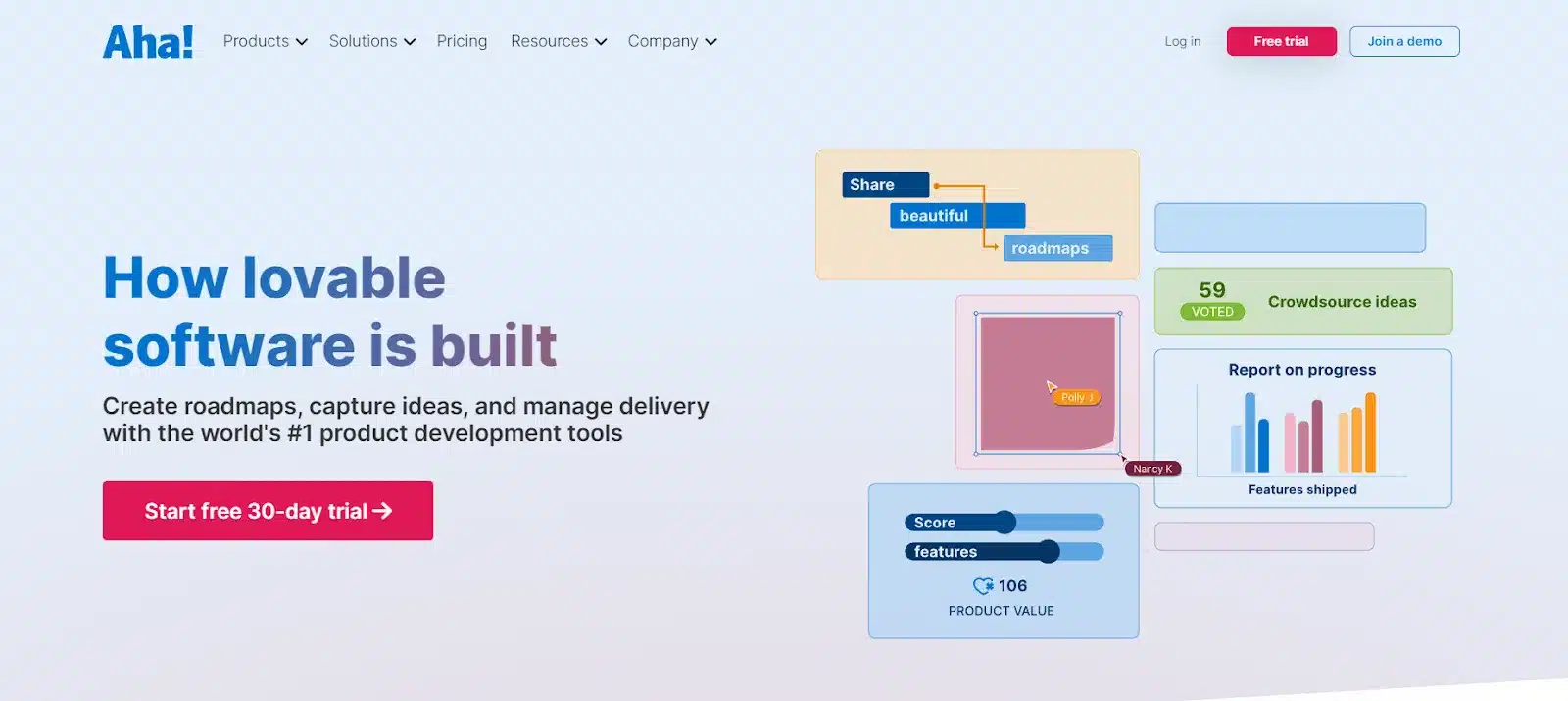
Aha! is a product roadmap software that helps businesses create, plan, and execute product strategies. It provides a centralized platform for product management and allows users to visualize their product roadmap, prioritize features, and collaborate with teams across different departments.
Notable Features
1. Collaboration
Aha! offers a robust set of collaboration tools to help teams work together effectively. These tools include shared calendars, task lists, and team chat, as well as the ability to comment and collaborate on specific features or user stories.
2. Alignment
Aha! tool enables you to align all your product work with your strategic objectives. It offers a range of features to help you articulate and capture your product vision, positioning, and go-to-market plans. With its capabilities to define your customer personas and track competitors with in-depth profiles, you can better segment your market.
3. Reports
The tool enables users to generate product management reports with ease. Users can select from over 75 prebuilt report templates and visualize data using charts, list reports, and pivot tables to gain meaningful insights. The tool also offers an interactive dashboard to track product progress and KPIs in real-time.
Pros of Aha!
- One of the key features of Aha! is its customizable product roadmap, which enables users to build and share their product roadmap with stakeholders.
- The platform also provides a wide range of templates and visualization tools to help users create their product roadmap quickly and easily.
Cons of Aha!
- The tool is versatile which makes it unavoidably complex and some users may find the roadmap visualization not very intuitive.
- Understanding the settings requires extensive research, making it difficult to discern which settings are managed at the top level versus the workspace level.
12. Monday
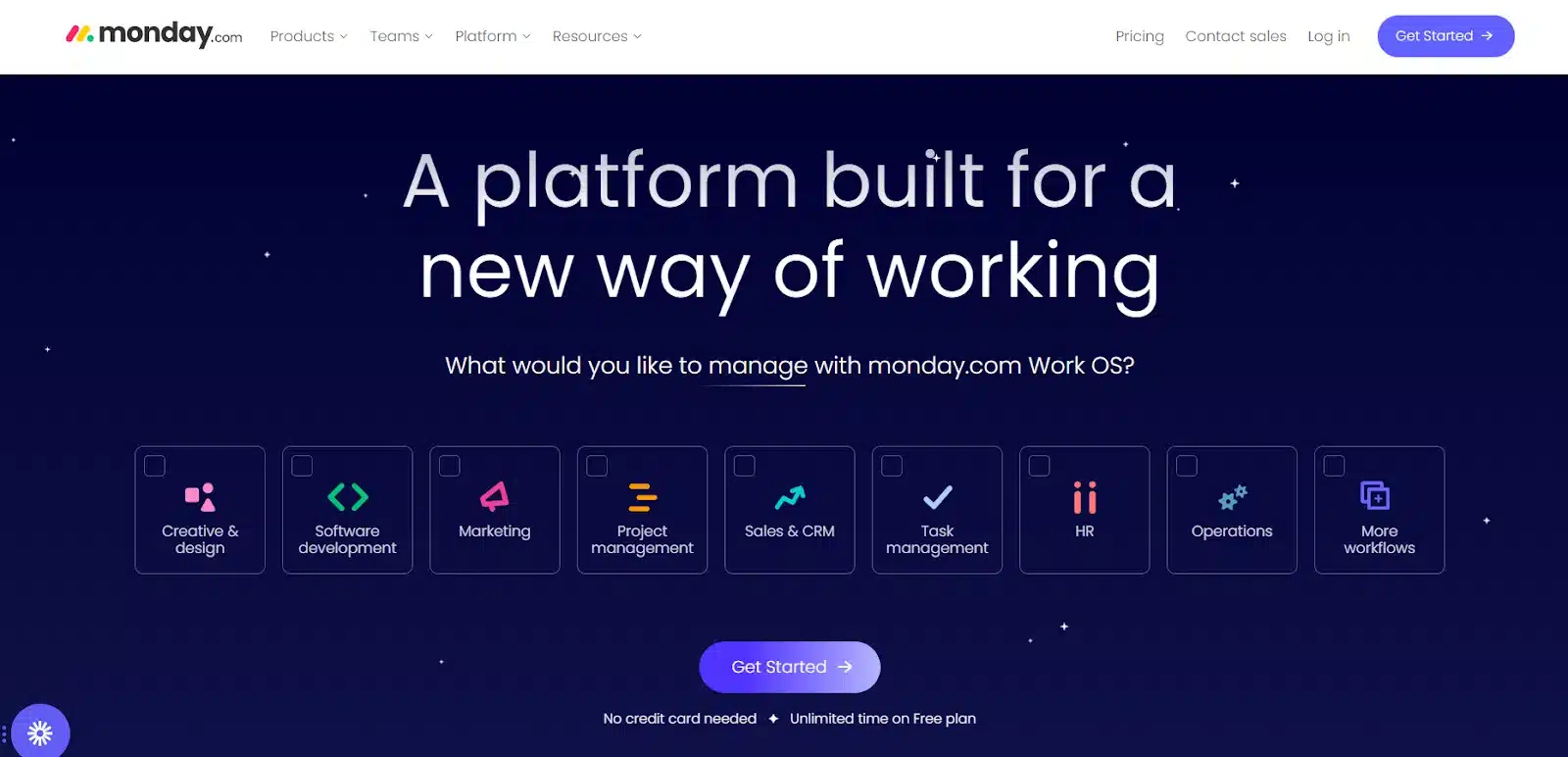
Monday.com is a collaborative project management platform that offers a visually engaging way for teams to organize their work. Its extensive list of features includes task management, project tracking, team collaboration, and reporting.
Notable Features
1. Comprehensive Work Management
Monday offers a complete solution for managing all aspects of work, empowering teams to execute tasks, projects, and processes efficiently and achieve shared goals at scale.
2. Customizable Boards
The board feature on Monday provides a flexible and customizable way to manage various items, from projects to departments. It serves as a starting point for organizing and optimizing workflows, streamlining communication, and ensuring accountability.
3. Efficient Goal Tracking
Monday helps you efficiently achieve your goals through customizable dashboards that provide a high-level overview of your organization. With these dashboards, you can make informed decisions, track progress, and easily scale workflows to meet evolving needs.
Pros of Monday
- Monday.com offers a highly customizable dashboard feature that allows users to create a personalized view of their work.
- The automation capabilities of Monday enables users to create workflows that automate repetitive tasks like sending reminders or updating project status, increasing productivity.
- It offers integrations with other popular tools such as Google Drive, Slack, and Trello, enabling users to streamline their workflows across multiple platforms.
Cons of Monday
- The platform experiences delays at times, especially when multiple files are added to a single table.
- Users may feel overwhelmed because of the range of functions offered by Monday, resulting in a steep learning curve.
- Customization options are not very robust. For example, some limitations exist in terms of visible date restrictions or highlighting dates for specific events, either through APIs or manual board adjustments.
13. ClickUp
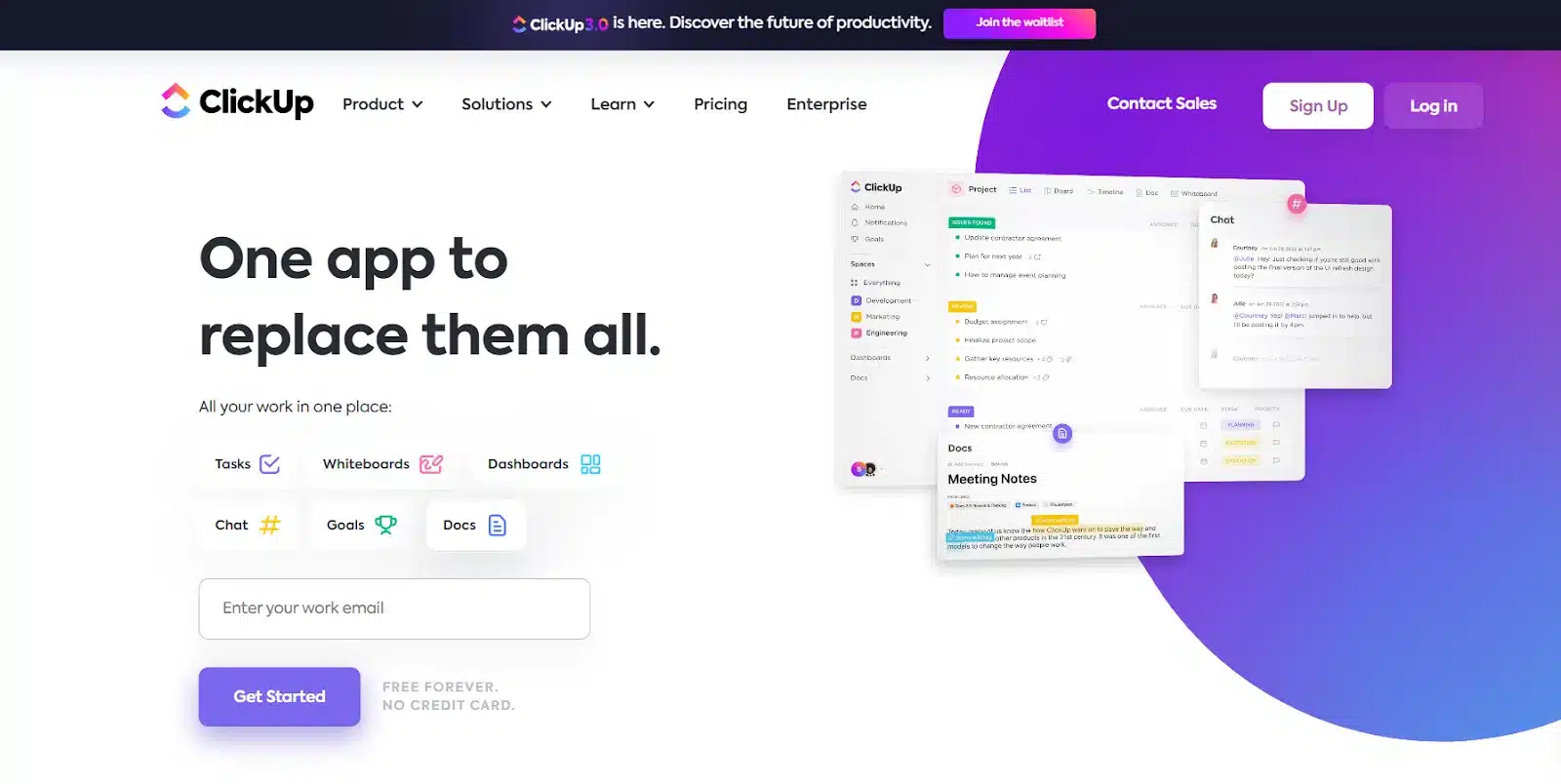
ClickUp is a productivity and project management tool that is designed to assist teams of all sizes in optimizing their workflows and improving project management. It offers numerous customizable features and functionalities that can be tailored to the unique needs of each team.
Notable Features
1. Task Management tool
ClickUp offers a highly customizable task management feature that can be tailored to meet the unique requirements of any team. From setting deadlines, assigning tasks to team members, including descriptions, comments, files, and much more, teams can efficiently manage their tasks in one place.
2. Real-time Collaboration
ClickUp’s real-time collaboration feature enables team members to work together seamlessly. Shared spaces can be designated for specific projects or teams, and invitations can be extended to relevant members. This helps ensure that everyone is on the same page and working towards the same objectives.
3. Automation
ClickUp provides users with automation capabilities that can help save time and reduce manual work. Teams can set up automated notifications and reminders, establish custom workflows, and create recurring tasks, making it easier to focus on high-value tasks.
Pros of ClickUp
- ClickUp has a very user-friendly interface which enables anyone to use it quickly without spending too much time.
- ClickUp provides various task creation options, including lists, boards, calendars, tables, and more, allowing teams to choose the format that best suits their workflow and preferences.
- It enables teams to create custom fields and tags, which can be used to organize tasks based on priority, status, or any other criteria that align with the team’s specific requirements.
Cons of ClickUp
- Even though the UI is user friendly, for new users it can be difficult to explore and use all the intricate features of the software.
- It often suffers from glitches and slow loading times.
14. Wrike
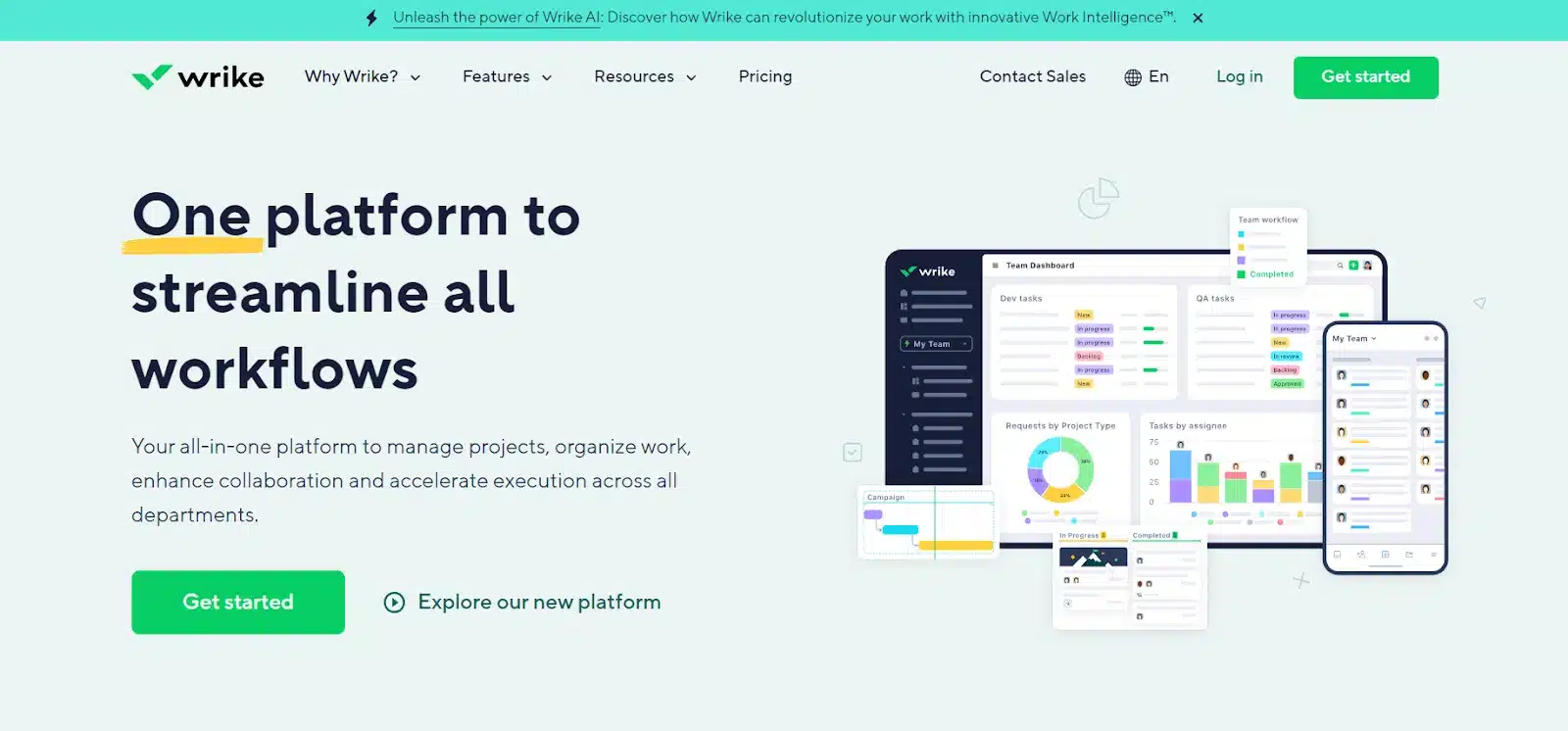
Wrike is a project management software that enables teams to collaborate on projects, automate workflows, and streamline their work processes. It offers a wide range of features that cater to the needs of teams of all sizes and industries.
Notable Features
1. Work Management capabilities
One of the key features of Wrike is its project management capabilities. It allows teams to create and manage projects, assign tasks to team members, and track progress in real-time. With Wrike’s Gantt charts, users can visualize project timelines, dependencies, and milestones to ensure that everything stays on track.
2. Automation
The software enables users to automate routine tasks, such as sending notifications, updating tasks, and setting reminders. This helps teams save time and ensures that everything is done efficiently.
3. Proofing
Improve your creative workflow with Wrike’s online proofing platform. It helps eliminate the need to juggle different file types or switch between tools by utilizing Wrike’s all-in-one platform. With online proofing, you can maximize creative output and create more assets in less time.
Pros of Wrike
- You can easily customize tasks, boards, and folders for different departments in your company with powerful customization features.
- It offers real-time collaboration which enhances productivity, communication, and organization between agency units.
- The tool also enables teams to prioritize tasks and track time spent on each task.
Cons of Wrike
- Wrike requires some training to utilize it effectively. It may seem challenging to use.
- Another drawback of Wrike is its low flexibility. To fully leverage its potential, users must conform to its logic and structure.
15. Airtable
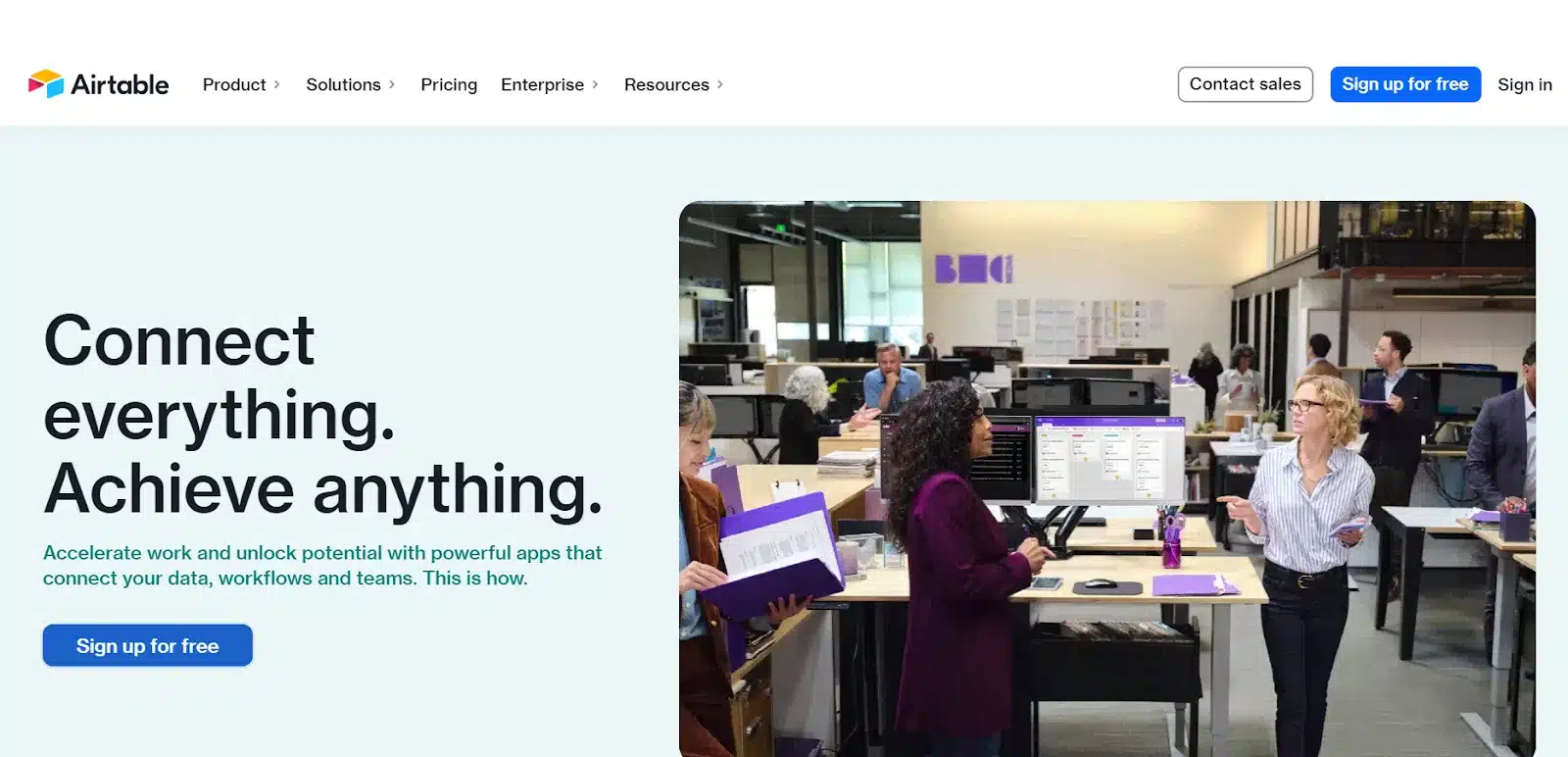
Airtable is a collaboration platform that combines the functionality of a spreadsheet with a database. It allows users to create and customize databases to organize and manage various types of data, such as project workflows, customer information, inventory tracking, and more.
Notable Features
1. Customization
Users can customize their databases using a variety of templates, fields, and views. The templates allow users to create pre-built databases for specific use cases, such as project management, content planning, or event planning. The fields allow users to add various types of data to their databases, such as text, attachments, checkboxes, or dropdown menus.
2. Marketing features
Airtable helps achieve marketing impact and innovation by establishing a single source of truth. It unifies all functions and works collaboratively to produce innovative campaigns that drive your business forward.
3. Centralized Insights
It helps you centralize and analyze all your feedback. It enables you to gather your customers’ insights in one place, ensuring that your development efforts are aligned with the right direction.
Pros of Airtable
- The interface is user-friendly and the dashboards can be easily customized according to my preferences.
- Its customizable workflows and templates enable you to manage projects efficiently.
- The integration capabilities also make it easier to collaborate with team members who use different platforms.
Cons of Airtable
- It is expensive especially if you need only the basic features
- Their customer support is not very robust. They offer minimal live assistance, and it may take several days to receive a response to inquiries.
Conclusion
When strategizing, it is essential to revisit and update your strategic plan regularly to ensure that it remains relevant and aligned with your organization’s priorities.
As you evaluate your plan, consider your progress towards your goals, changes in the business environment, and feedback from stakeholders. And the easiest way to do that is through a robust tool.
Strategic planning softwares help you to establish a clear vision, set goals, and allocate resources effectively. To choose the right tool for your organization, consider factors such as the size of your organization, the complexity of your operations, and the skills of your team members. These are some of the best strategic planning softwares in the market that will help you not only in planning but in strategy execution as well.
To get a hang of how an efficient strategic planning tool should feel like, you can take a demo from Peoplebox.








